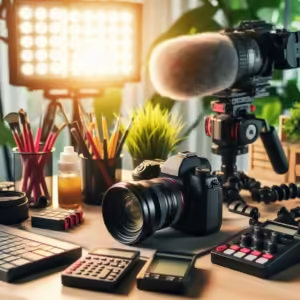Creating a video commercial can seem tricky, especially if you’re just starting out. However, with a clear plan and the right tools, anyone can make an effective video that captures attention. This guide will help you understand each step, from the basics of video commercials to promoting your finished product. By the end, you’ll be ready to create a video that showcases your brand and connects with your audience.
Key Takeaways
- Video commercials are powerful tools for attracting customers and building brand awareness.
- Planning is essential; know your goals and audience before you start creating.
- Good equipment helps improve the quality of your videos, but you don’t need to spend a lot to get started.
- Editing is where you can make your video shine and keep viewers engaged.
- Promoting your video on social media and other platforms is key to reaching a wider audience.
Understanding the Basics of Video Commercials
What is a Video Commercial?
A video commercial is a short film designed to promote a product or service. These commercials aim to grab attention quickly and convey a message in a fun and engaging way. They can be found on TV, social media, and websites.

Why Video Commercials Matter
Video commercials are important because they help businesses connect with their audience. They can:
- Increase brand awareness
- Showcase products effectively
- Drive sales and engagement
In today’s fast-paced world, a well-made video can make a big difference in how people see your brand. Video marketing is essential for standing out!
Types of Video Commercials
There are several types of video commercials, each serving a different purpose:
- Brand Commercials: Focus on the brand’s story and values.
- Product Demos: Show how a product works in real life.
- Testimonials: Feature happy customers sharing their experiences.
- Event Promotions: Highlight upcoming events or sales.
| Type of Commercial | Purpose |
|---|---|
| Brand Commercial | Build brand identity |
| Product Demo | Explain product features |
| Testimonial | Build trust with potential customers |
| Event Promotion | Drive attendance to events |
Remember, a strong video commercial can create instant connections with your audience. It’s all about telling your story in a way that resonates with them!
Planning Your Video Commercial

Defining Your Goals and Audience
Before you start filming, it’s super important to know what you want to achieve. Setting clear goals helps you stay focused. Here are some things to consider:
- What message do you want to share?
- Who is your target audience?
- What action do you want viewers to take after watching?
Understanding your audience is key. Research their interests and preferences to create content that resonates with them. You can do this in a variety of ways and even use AI to research your target audience. This will make your video more effective and engaging.
Creating a Compelling Script
A great script is the backbone of your video. Start with a strong hook to grab attention. Here’s how to write a solid script:
- Outline the main points you want to cover.
- Keep it simple and direct.
- Include a clear call-to-action at the end.
Remember, a well-structured script saves time during filming and editing!
Storyboarding Your Ideas
Storyboarding is like creating a visual plan for your video. It helps you organize your thoughts and ensures you don’t miss any important shots. Here’s how to do it:
- Sketch out each scene.
- Write down key actions and dialogues.
- Use it as a guide during filming.
Planning your video content carefully can save you a lot of time and effort in the long run. It helps you stay focused and ensures that your final product aligns with your goals.
By following these steps, you’ll be well on your way to creating a video commercial that not only looks great but also effectively communicates your message. Don’t forget to check out resources for creating engaging course videos, as they can provide valuable insights for your project!
Gathering the Right Equipment
When it comes to creating a video commercial, having the right gear is super important. Good equipment can make your video look professional and engaging. Here’s what you need to consider:

Essential Camera Gear
- Camera: You don’t need the fanciest one; even a good smartphone can work!
- Lenses: If you can, invest in quality lenses for better shots.
- Tripod: A stable shot is key, so don’t skip this!
Lighting and Sound Equipment
- Lighting: Softbox lights or ring lights can help brighten your scene without harsh shadows.
- Microphones: Clear audio is a must! Consider using lavalier mics for close-ups or boom mics for wider shots.
- Soundproofing: If filming indoors, use foam panels to reduce echo.
Budget-Friendly Alternatives
- Rent Equipment: If you can’t buy, renting is a great option.
- DIY Solutions: Use household items for lighting or backdrops.
- Smartphones: Many smartphones have excellent cameras and can be a great starting point.
Remember, investing in the right equipment can significantly improve the quality of your video, making it more engaging and professional.
Filming Your Video Commercial
Setting Up Your Shooting Space
Creating a great video starts with a good setup. Here are some tips to make your shooting space work for you:
- Choose a quiet location to avoid background noise.
- Use good lighting; natural light is great, but softbox lights can help too.
- Keep your background clean and uncluttered to keep the focus on your subject.
Filming Techniques for Beginners
When you’re ready to film, remember these simple techniques:
- Use the rule of thirds to frame your shots nicely.
- Keep the camera rolling for a few extra seconds at the start and end of each shot.
- Experiment with angles; try close-ups and wide shots to keep things interesting.
Recording High-Quality Audio
Good audio is just as important as good video. Here’s how to ensure your sound is clear:
- Invest in a decent microphone; it makes a big difference.
- Test your audio levels before you start recording.
- Minimize background noise by closing windows and doors.
Remember, the goal is to create engaging content. Don’t stress about perfection; just focus on getting your message across!
Editing and Optimizing Your Video
Basic Editing Techniques
Editing is where the magic happens! Here are some basic techniques to get you started:
- Cutting: Trim unnecessary parts to keep your video engaging.
- Transitions: Use simple transitions to make your video flow smoothly.
- Text Overlays: Add text to highlight key points or provide context.
Adding Visuals and Graphics
Visuals can make your video pop! Here’s how to use them effectively:
- Choose colors and styles that match your brand.
- Use graphics to highlight key points. This keeps viewers engaged and helps them remember your message.
- Don’t forget about transitions! Smooth transitions can make your video feel professional.
Optimizing for Different Platforms
To ensure your video reaches the right audience, consider these tips:
- Choose the Right Video Format: MP4 is a popular choice because it balances quality and file size.
- Compress Videos: Make sure your videos load quickly without losing quality.
- SEO Best Practices: Use relevant keywords in your video title and description to improve visibility.
Remember, a well-edited video can turn casual viewers into loyal customers. Invest time in editing to enhance your message!
Promoting Your Video Commercial
Using Social Media Effectively
Social media is a fantastic way to get your video in front of more people. Here are some tips to make the most of it:
- Share snippets or teasers to grab attention.
- Use engaging captions and relevant hashtags.
- Encourage your followers to share your content.
Collaborating with Influencers
Working with influencers can help you reach a wider audience. They can share your video with their followers, which can boost your visibility. Here’s how to do it:
- Find influencers who align with your brand.
- Reach out and propose a collaboration.
- Create content that feels authentic to both your brand and theirs.
Utilizing Paid Advertising
If you want to reach even more people, consider using paid ads. Platforms like Facebook and Instagram offer targeted advertising options. Here’s a quick overview:
| Platform | Ad Type | Targeting Options |
|---|---|---|
| Video Ads | Demographics, Interests | |
| Story Ads | Location, Behaviors | |
| YouTube | Skippable Ads | Keywords, Topics |
Remember, promoting your video is just as important as creating it. Get it out there and watch your audience grow!
Analyzing and Improving Your Video Commercials
Tracking Performance Metrics
To know if your video commercial is working, you need to track its performance. Here are some key metrics to keep an eye on:
- Views: How many people watched your video?
- Engagement Rate: Are viewers liking, sharing, or commenting?
- Conversion Rate: Did viewers take action, like visiting your website or making a purchase?
| Metric | Description | Importance |
|---|---|---|
| Views | Total number of times viewed | Basic measure of reach |
| Engagement Rate | Likes, shares, comments | Indicates viewer interest |
| Conversion Rate | Actions taken after viewing | Shows effectiveness of the ad |
Gathering Audience Feedback
Getting feedback from your audience is crucial. Here’s how to do it:
- Surveys: Ask viewers what they liked or didn’t like.
- Comments: Read through comments on social media or video platforms.
- Focus Groups: Gather a small group to discuss their thoughts on your video.
Remember, feedback is a gift! It helps you understand what resonates with your audience and what doesn’t.
Making Data-Driven Improvements
Once you have your metrics and feedback, it’s time to make changes. Here are some steps to follow:
- Analyze the Data: Look for patterns in the metrics and feedback.
- Identify Weak Spots: Find areas where your video didn’t perform well.
- Test Changes: Make adjustments and test new versions of your video.
By focusing on these areas, you can continuously improve your video commercials and make them more effective. Video marketing is a journey, and every step counts!
Wrapping It Up: Your Journey to Video Success
Creating a video commercial might feel like a big task, but it can be a fun adventure! Remember, every great video starts with a simple idea. Take your time to plan, shoot, and edit, and don’t forget to share your work with the world. With practice, you’ll get better and more confident in your skills. So, grab your camera, let your creativity flow, and start making videos that shine! You’ve got this, and we can’t wait to see what you create!
Frequently Asked Questions
What exactly is a video commercial?
A video commercial is a short video made to promote a product or service. It usually aims to grab the viewer’s attention and encourage them to take action, like buying something or visiting a website.
Why are video commercials important?
Video commercials are important because they can quickly grab people’s attention and keep them interested. They help businesses communicate their message effectively and reach a larger audience.
What are some different types of video commercials?
There are many types of video commercials, including explainer videos, product demos, testimonials, and brand stories. Each type serves a different purpose and can connect with viewers in unique ways.
What equipment do I need to make a video commercial?
To make a video commercial, you’ll need a camera (like a smartphone or a DSLR), a microphone for clear sound, and good lighting. You can also use editing software to polish your video.
How can I promote my video commercial once it’s made?
You can promote your video commercial by sharing it on social media, embedding it on your website, and sending it out in email newsletters. Collaborating with influencers can also help widen your reach.
How do I measure the success of my video commercial?
You can measure success by tracking views, likes, shares, and comments. Tools like Google Analytics can help you understand how well your video is performing and what improvements you can make.

